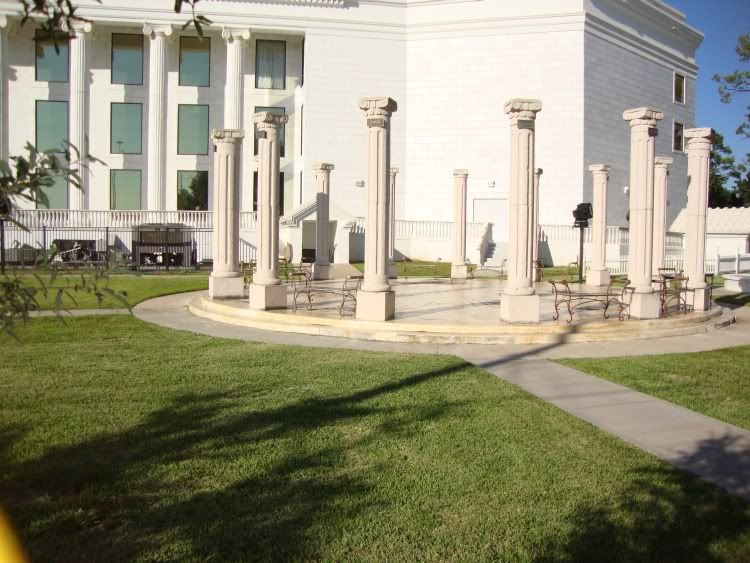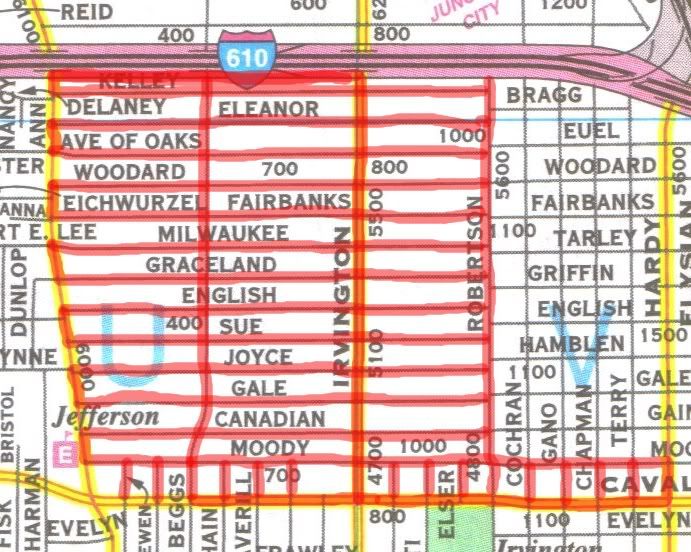
After a long hiatus, I am restarting my "
Houston Streets" bicycle travelogue series. This time, I was inspired by a post about the area on the ever excellent
Swamplot to give Idylwood a look. Specifically the comments peeked my interest. There were a few negative ones about the East Side, which brought a bunch of impassioned defenders. I checked it out on the map and was intrigued by its Brays Bayou location. So I loaded the bike in the station wagon and drove out for a look.
It's a rather isolated neighborhood in some ways. Across Wayside is a giant convent (probably not too many raucous parties there). Across Lawndale is a golf course. Of course, Brays Bayou forms its eastern border, and on the other side of Brays Bayou is the enormous Forest Park Cemetery. There are a few crappy apartments between the neighborhood and I-45, though. Anyway, it's a good neighborhood, and the residents are determined to keep it that way.

It is deed restricted, and the civic association is obviously very active. (This was confirmed in a discussion with a resident--more later.)
One thing that is really cool about the neighborhood--but also the source of much pain--is that it is right next to Brays Bayou. North MacGregor runs along the bayou (this is not connected with the MacGregor that connects the Medical Center with MacGregor Park--that's about a mile and a half west of Idylwood. Houston lacks impressive bodies of water--there are no great rivers, lakes, or bays in the city. We have a few roads that run along bayous which are quite lovely, but they are all relatively high-speed arterials (Memorial, Allen Parkway, the other MacGregor/Braeswood, and T.C. Jester). This is the only
neighborhood street that runs along a bayou that I have found. It's the kind of street that you wouldn't feel like you were risking body and soul by riding or jogging along it. And what a great view for cyclists!

I wish I had taken some closer photos of the metal and concrete structures you can see along the road. I meant to (more later). These are recent additions to the bayou, put in by the Harris County flood control after Ike. In addition to building some flood-control structures, they have condemned some properties. Several houses have been torn down and a few more are on the chopping block.

This house on MacGregor at Fairfield looks like it will be relocated. The resident I spoke with said that the lots where the houses were would be maintained by Harris County, and that they could be
used by the neighborhood but that no one could
build anything there. The problem is that they will become, in essence, a commons. This fellow said that if they start a community garden (one idea that had been floated), there would be no enforcement mechanism to keep anyone from stealing veggies. (I would be worrying about felonious nuns with garden shovels.)

His house was
not one of the condemned ones, and as you can see, it is way up on a high bank. It must have a stunning view, especially from that beautiful covered balcony on the left side. Nonetheless, he said water had gotten just a foot below his front door. Scary.

This is my favorite house in the neighborhood. It's on MacGregor at Meadowlawn. It could use a little restoration, but I love the
moderne lines of it and the color.
If you look at the map, it looks like Maxwell connects Idylwood with the I-45 feeder road. There is, however, a gate across Maxwell to prevent vehicles from using it as a through street. Bikes can get through, fortunately. On the east side of Maxwell is a large modern building that houses the
AAMA, the Association for the Advancement of Mexican-Americans. This is also the location of the
George I. Sanchez High School, a charter school operated by the AAMA.

The front of the AAMA building is quite striking.

Too bad that on the east side of Maxwell is the apparently abandoned headquarters of Oshman's. Oshman's was a staple sporting goods store in Houston, started in 1912. I bought my first Converse hightops at an Oshman's when I was in high school. Oshman's merged with a national sporting goods store holding company, Garts, in 2001, and Garts merged with The Sports Authority in 2003. No more Oshman's, except for a few ghostly remnants like this building.
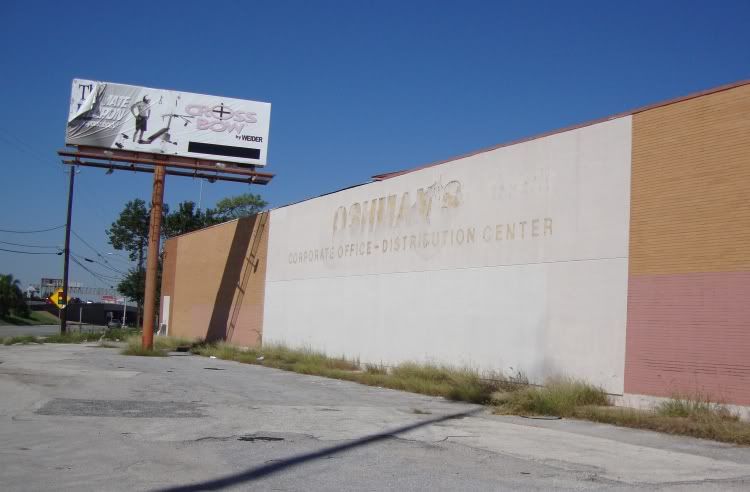
It's hard to read, but the side of the building once read Oshman's Corporate Office - Distribution Center. According to HCAD, the building is owned by
Weingarten Realty Investors--apparently one of their many non-income-producing properties.
But while it was functioning, Oshman's allowed some Mexican American painters to cover its entire long southeast wall with a bizarre mural that combines Mexican motifs and all kinds of sports.

The mural, which seems to have been partially funded by the
HAA and had some undefined
Orange Show participation, is fading away now.

As murals go, this one wasn't all that good, but it's worth taking a look at--some of the details are pretty amusing.
I wanted to check out the cemetery across Brays Bayou from Idylwood. This shot was taken from the Lawndale bridge as I rode over. This is looking northeast, downstream along the bayou.
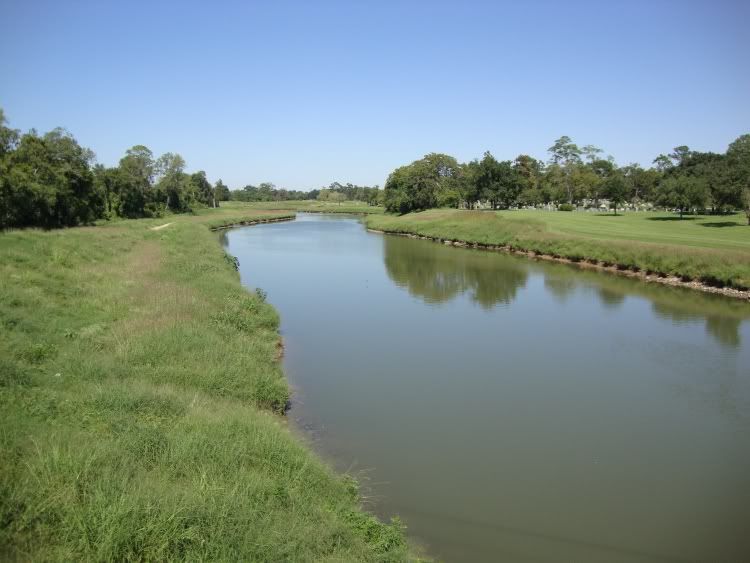
Brays Bayou is huge here, which is not too far from where it empties into the Ship Channel. There are paths along the bayou at various points, but not here or through Idylwood. Since they have put up those nice metal fences (topping the concrete flood control walls), they should go whole hog and build a hike-bike path.
Forest Park Cemetery is very, very large. I mainly wanted to go there so I could photograph Idylwood from the other side of the bayou. I hoped to have a good shot of the flood control structures, which are surprisingly attractive. You can see a long U-shaped road (surrounding the word "Forest" on the map above) that would be the perfect place from which to take a picture. However, as I was riding down it, I was chased by three very angry dogs! Surely they can't belong to the cemetery--they were chasing me through an area full of graves where people leave flowers. They're a lawsuit waiting to happen. Are they neighborhood dogs that have taken over one section of the cemetery? Whatever the case, they didn't want me to be right where I wanted to be, and the three beasts vigorously chased me from their self-defined territory. It was terrifying, and it ruined the photo I wanted to take.
Still, they only "controlled" a tiny part of the whole cemetery, and I was able to get some interesting photos.

Like this odd life-size stone statue of an Asian-looking water well. It didn't seem to be part of anyone's plot. It was near a large family plot for a family named Yang, but there were several non-Asian family plots even closer.
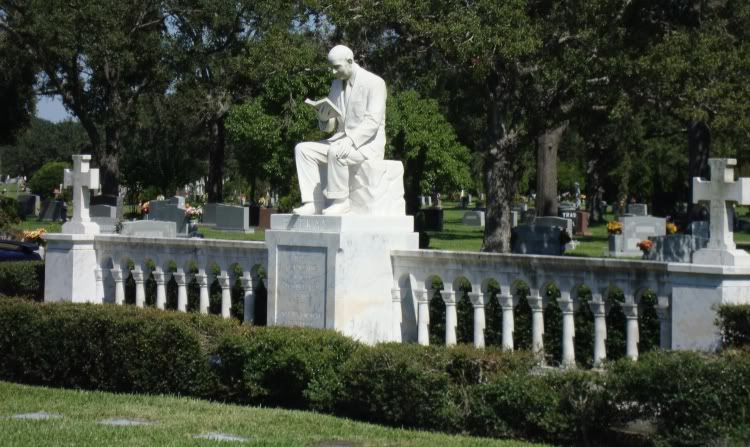
I loved this statue--it look likes a sculptor poured real work and talent into it, and I like the thought of reading for eternity. (Personally, I wouldn't be wearing a suit and tie to read for eternity, but it does give this fellow a lot of dignity.)

This one was bizarre--it almost looks like a tombstone for the City of Houston, with a portrait of its skyline. The car under the words United Forever is nice touch. But apparently it is a grave for a fellow named Bennie Lee (1924-1987). I think it may be that he is united forever with the city of Houston, which is a beautiful thought. Or horrifying. I can't decide. I like the naive drawing style on the tombstone--it contrasts with the skilled but conventional off-the-shelf designs on many other tombstones, and I like it better than the laser-etched photos some have (although those can be pretty moving, too).
Labels: 77023, Houston Streets, Idylwood


